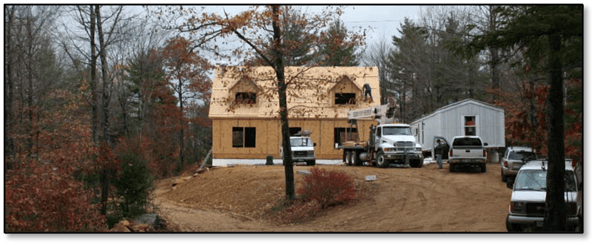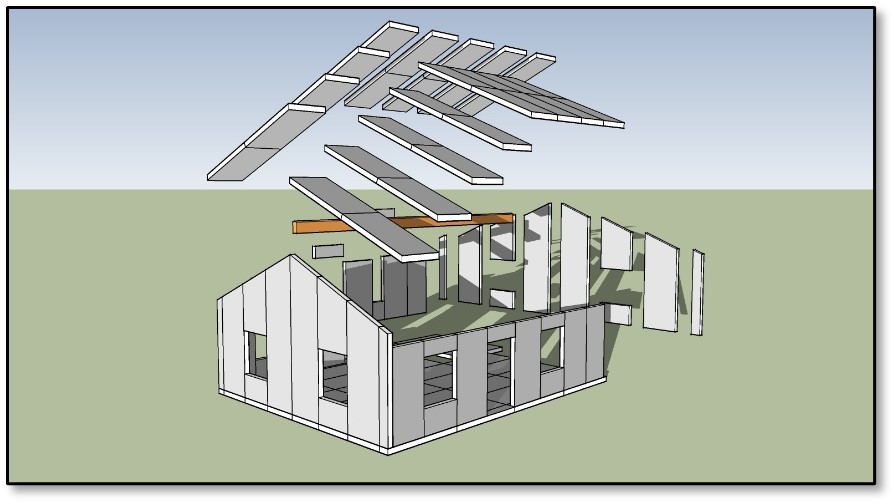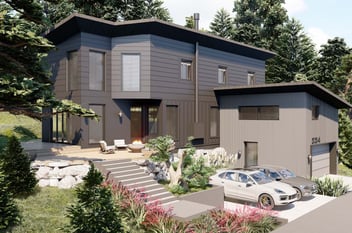What do MgO + Passive House™ Panels Really Cost vs Wood Framing?
One of the most common questions we hear is “OK, so what will it really cost me?”
Obviously, the answer depends upon a lot of things, but the basic truth is that when one is looking to save labor and time, which are certainly costs, choosing a properly designed panelized wall system typically saves more time and labor than choosing wood framing. Wood (stick) framing used to be considered as the “most common, affordable, and the preferable" kind of construction, but the 2006 “Time & Motion Study” by RSMeans, the US’ largest and most respected cost estimating company, proves that panels are really the more time and labor-efficient way to build.
Getting the Data
In its Study, RSMeans (“Means”) monitored the time taken to build a 2-story, three bedroom, 42’x28’ cape style home with three dormers on a 12/12 pitch roof, all made with OSB SIPs (oriented strand board-faced structural insulated panels). Means then estimated the time that the same house would have taken if it had been “Stick Built” (based upon decades of their recording time and costs across the US) and then Means compared the time and labor costs between the 2 building systems.

Means found that the panelized home was 55% faster to complete and used 41% less labor than the conventional 2x6 wood framed construction. See pages 26 and 19 (respectively) in the Means “Time & Motion Study” for the documentation of these findings.
An important fact is that Means did not consider the cost of materials in the Study. They stated on page 6, “The volatility of material costs can vary greatly by the project size, geography, and market. For these reasons, the material cost is not included in the summary of costs within this report.” We’ll address current material costs in the last Table below and see how today it’s really the labor costs that are the biggest expenses and risks.
Looking at the Means Data
Means studied actual labor amounts experienced for each part of the project’s “shell” (walls, roof, and dormers), and also recorded the time taken for each individual task, even for items such as “Unwrapping Panels”, and tallied tasks to the nearest 5 minutes.
MEANS FOUND LARGE TIME SAVINGS WITH SIPs:
| BUILDING SYSTEEMS: | WALLS (HRS.): | ROOF (HRS.): | DORMERS (HRS.): | TOTALS (HRS.): |
| STICK-BUILT SHELL | 78.12 | 117.48 | 41.87 | 237.47 |
| SIP SHELL | 24.876 | 50.84 | 31.33 | 106.93 |
| HOURS SAVED BY SIPS | 53.36 | 66.84 | 10.54 | 130.54 |
| TOTAL TIME DIFFERENCE | - | - | - | -55% |
In terms of time, nearly two (1.82) times more SIP homes could have been built in the same time that it normally takes to build the same home out of sticks.
MEANS FOUND LARGE LABOR COST SAVINGS WITH SIPs:
| BUILDING SYSTEM: | WALLS: | ROOF: | DORMERS: | TOTALS: |
| STICK-BUILT SHELL | $3,331 | $4,998 | $1,765 | $10,094 |
| SIP SHELL | $1,372 | $2,816 | $1,735 | $5,923 |
| LABOR COSTS SAVED BY SIPS | $1,959 | $2,182 | $30 | $4,171 |
| TOTAL LABOR COST DIFFERENCE | - | - | - | -41% |
In terms of labor costs, nearly 2 1/2 (2.44) times more SIP homes could have been built for the same amount of labor that it normally takes to build the same home out of sticks.
For Wall Labor, Means noted on page 15 of their Study that, “Labor costs for a 6 ½” SIPs wall are $0.97/square foot, while a conventional wall is expected to have labor cost of $2.37/square foot (2006 dollars)." That says OSB panels offer an "on the job" labor savings of 59% over stick construction. An important fact for today’s market considerations is that MgO panels, which are of a higher quality than OSB, are installed very similarly to the way that the OSB panels are installed. Labor costs are essentially the same for both kinds of SIPs. It's also important to note is that some Passive House™ panels, such as the Simplus Building System ™, install nearly identically to MgO panels. However, many other Passive House™ wall systems are actually just multiple layers of stick framing and use a lot more time, labor, and materials than do "single" panel Passive House™ panel walls, such as the Simplus Building System ™ walls. And always, with any kind of construction, proper building designs should be used to get the most value for the money.
Applying the Data to Today’s Realities
Today’s (2023) labor costs are definitely more than they were in 2006, and although labor costs vary quite a lot from location to location, in much of the U.S. there is a shortage of skilled labor. In the Reno, NV area, a local, medium to large-sized General Contractor (a "Commercial" or "Generalist" Builder) with conventional overhead costs has to pay wages that are adequate to retain legal workers in this competitive market. In September of 2023, that same wood stud wall now costs that Reno contractor about $15.25 per s.f. for labor (nearly 6 ½ times more than in 2006), even using non-union wages. Worse yet, labor costs today are higher while productivity is often lower due to fewer skilled workers on the jobs.
Labor is often one of the most expensive and unpredictable costs on a job today. Unmotivated, poorly trained, and hard to find workers expose many contractors and their clients to defects, delays, and cost overruns. Labor prices vary from company to company, and contractors who are experienced erecting panelized buildings definitely offer a cost advantage over the contractors who are still stuck in the wood stick framing Old Ways of building. With factory-built systems like MgO panels that deliver prefabricated, ready to set, and nearly problem-free components to the job site, those contractors that are experienced in setting panels can generate rapid progress and reliable value for the client, eliminating most of that labor and time risks from the project
Beyond economical construction, one also needs energy efficient construction. Using Passive House™ design and construction methods is the most effective and sensible way to save energy, and it just involves upgrading the quality and quantity of insulation, windows, doors, and air/vapor control methods while reducing thermal bridges and greatly downsizing your mechanical systems. When it comes to walls, roofs, and floors, the Simplus Building System™ combines Passive House™ technologies with Panelization technologies, and as a result one can obtain the more beneficial Net Zero Ready envelope features in a single, easy to use, quick to erect, and more affordable wall panel, as shown in the following Table.
The Bottom-Line Proof of Costs
2023 STUD WALL PRICES COMPARED TO OTHER OPTIONS:
| WALL SYSTEM: | LABOR: | MATERIALS: | EQUIPMENT: | TOTALS: | NOTES: |
| ALL PRICING IS PER S.F. OF WALL AREA, IS BASED UPON RENO, NV INFORMATION, AND IS WITHOUT PROTECTIVE WALL MEMBRANES AND FINISH MATERIALS, SUCH AS EXTERIOR SIDING, INTERIOR TEXURE, AND PAINT. |
|||||
|
2X6 WOOD STUDS @ 16" O.C. with R-19 F.G. Insulation & 1/2" Gypsum Board at interior |
$15.25 | $3.40 | $0.00 | $18.65 |
FORKLIFT OPTIONAL GENERALIST BUILDER PRICING |
|
6 1/2" MgO SIPs- 5 1/2" insulated core with 1-layer of 1/2" MgO sheeting both sides. Interior MgO sheet can be finished similarly to gypsum board |
$6.25∗
∗Labor calculated using 59% labor savings documented by RSMeans and commercial builder labor rates.-
|
$15.00 | $0.00 | $21.25 |
FORKLIFT OPTIONAL EXTRA GENERALIST BUILDER LABOR PRICING PANEL PRICING PER MANUFACTURER |
|
COMBINED- PASSIVE HOUSETM + MgO SIPs (SIMPLUSTM) GENERALIST BUILDER PRICING |
$6.25∗
∗Labor calculated using 59% labor savings for panels documented by RSMeans applied to commercial builder labor rates.
|
$17.35 | $0.00 | $23.60 |
FORKLIFT OPTIONAL EXTRA GENERALIST BUILDER LABOR PRICING PANEL PRICING PER MANUFACTURER |
|
COMBINED- PASSIVE HOUSETM + MgO SIPs (SIMPLUSTM) SPECIALIST BUILDER PRICING |
$3.00∗∗
∗∗Using Panel Installation Specialist Labor Rate.
|
$17.35 | $0.00 | $20.35 |
FORKLIFT INCLUDED SPECIALIST BUILDER LABOR PRICING PANEL PRICING PER MANUFACTURER |
|
DOUBLE STUD WALL- TYPICAL PASSIVE HOUSETM CONSTRUCTION |
$19.25 (min.)
|
$5.75 | $0.00 | $25.00 | FORKLIFT OPTIONAL EXTRA |
|
8" CONCRETE BLOCK with 2" of rigid insulation & 1/2" gypsum board at interior |
$22.70
|
$9.75 | INCLUDED | $32.40 |
SCAFFOLDING INCLUDED FORKLIFT OPTIONAL EXTRA |
|
6" CONCRETE TILT-UP OR PRECAST with 2" of rigid insulation & 1/2" gypsum board at interior |
$15.65
|
$11.15 | INCLUDED | $26.80 |
CRANE INCLUDED FORKLIFT OPTIONAL EXTRA |
The numbers above show that as a rule one can have the benefits of MgO Panels, even with Passive House Design™ features included, for just a slight premium over traditional wood stick construction and for much less than heavier and very poorly insulating concrete and block walls. With an experienced panel installation contractor, the premium to go with an MgO system is almost negligible.
Considering that higher quality construction usually does cost more than lower quality construction, as it should since you "get more", then choosing "Significantly Better, Faster, and Sustainable" for a relatively small premium is certainly a very good investment. Since construction costs vary, your costs may be higher or lower depending upon a number of factors, such as the material supplier, the builder's labor costs, the builder's skill level, schedule, the local construction economy, profit and overhead factors, freight, taxes, and the complexity of your building design, but generally the relative pricings shown in the above table should hold true, proportionally.
And when one also considers: 1) that the Passive House™ MgO SIP construction can save you up to 90-95% of your energy bills while correspondingly reducing the amount of greenhouse gas emissions, 2) that MgO panels are stronger, highly fire-resistant, natural antifungal materials, and 3) that using Passive House™ design principles will give you a more comfortable and healthier building than any stick, block, brick, or concrete building, then it's a "no brainer" to choose panels like the Simplus Building System™.
So, who would want to pay more, take longer, get much less, and continue killing off life on the planet just to keep using the Old Ways of building? The Answer: Only those who are ignorant, unable, or who care more about money than the really important things.
We’re now facing an existential threat caused by using the Old Ways; the older, slower, more expensive, and thermally inefficient ways of building that burn more and more fossil fuels. It’s way past time to start using better ways of building. Panelized and Passive House™ systems are the Answer that we need, especially those building systems that puts it all together in one handy, reliable, easy, and fast to complete package.
Are you ready to become part of the Answer and stop being part of the Problem? If so, then make your life better and contact Tim Sweeney at Sweeney Architecture and learn how simple and easy saving time, money, and the planet can be.




